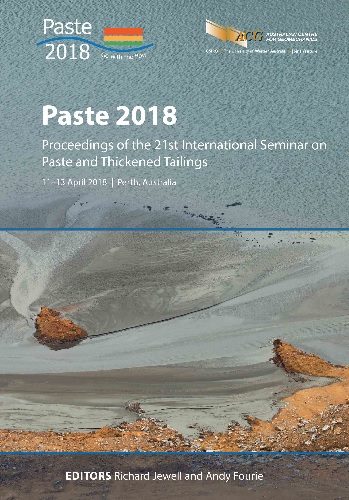Modern polyethylenes for wear and scaling applications

|
Authors: Lakous, E |
DOI https://doi.org/10.36487/ACG_rep/1805_41_Lakous
Cite As:
Lakous, E 2018, 'Modern polyethylenes for wear and scaling applications', in RJ Jewell & AB Fourie (eds), Paste 2018: Proceedings of the 21st International Seminar on Paste and Thickened Tailings, Australian Centre for Geomechanics, Perth, pp. 493-504, https://doi.org/10.36487/ACG_rep/1805_41_Lakous
Abstract:
This paper will seek to highlight the performance attributes of modern age polyethylenes, the use of which is being limited due to a lack of practical information in the marketplace, namely ambiguity over the definition of ultra-high molecular weight polyethylene (UHMWPE); lack of exposure to the performance characteristics of UHMWPE under real-life scenarios; and an incorrect perception of high pricing and lack of customisability. This paper should condense not only the known UHMWPE information but also reflect it as a subset of piping applications specifically. The UHMWPE family is traditionally thought of as the most impact and abrasion resistant of any PE, but it also has a technically unlimited number of grades (molecular weights) as defined by ISO 11542 (International Organization for Standardization 2001), which defines products only by their minimum melt flow index – an attribute not directly associable with abrasion or impact performance. This paper will seek to distinguish specific mechanical data with reference to pipeline performance for specific grades, subsequently correlating and comparing against each other and the baseline PE product, high-density polyethylene (HDPE, PE100). By directly comparing testing data and referencing site-specific performance, the author will endeavour to provide the first comprehensive article on this matter.
Keywords: scaling, wear, abrasion, slurry, ultra-high molecular weight polyethylene (UHMWPE)
References:
ASTM International 1993, ‘ASTM D256-92: Standard test methods for impact resistance of plastics and electrical insulating materials’, Annual Book of ASTM Standards, vol. 8.01, ASTM International, West Conshohocken, pp. 3–5.
ASTM International 2011, Standard Specification for Ultra-High-Molecular-Weight Polyethylene Molding and Extrusion Materials, ASTM D4020-11, ASTM International, West Conshohocken,
ASTM International 2012, Standard Test Method for Dilute Solution Viscosity of Ethylene Polymers, ASTM D1601-12, ASTM International, West Conshohocken,
ASTM International 2015, Standard Guide for Abrasion Resistance of Mortar Surfaces Using a Rotary Platform Abraser, ASTM C180315, ASTM International, West Conshohocken,
Braun, G & Theyssen, J 1979, ‘Ultra high molecular polyethylene – the material and its modifications’, Kautschuk, Gummi, Kunststoffe, August 1979, pp. 3–3.
International Organization for Standardization 1995, Plastics – Film and Sheeting – Determination of the Coefficients of Friction,
International Organization for Standardization 2001, ISO 11542-1:2001, Plastics – Ultra-high-molecular-weight Polyethylene
(PE-UHMW) Moulding and Extrusion Materials – Part 1: Designation System and Basis for Specifications, ISO, Geneva,
Stein HL 1999, Engineered Material Handbook, Volume 2: Engineered Plastics, ASM International, Materials Park.
Ticona GmbH 2007, PE-UHMW Technical Datasheet, Ticona GmbH, Frankfurt, pp. 1–3.
SAI Global 2012, EN295-3:2012, Vitrified Clay Pipe Systems for Drains and Sewers Part 3: Test Methods, SAI Global, Adelaide,
Stabok, J, Makselon, M & Tomanek, H 2007, ‘Erosion resistance testing of plastic pipes’, Journal of Achievements in Materials and Manufacturing Engineering, vol. 25, no. 2,
© Copyright 2024, Australian Centre for Geomechanics (ACG), The University of Western Australia. All rights reserved.
View copyright/legal information
Please direct any queries or error reports to repository-acg@uwa.edu.au
View copyright/legal information
Please direct any queries or error reports to repository-acg@uwa.edu.au



